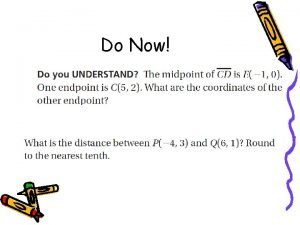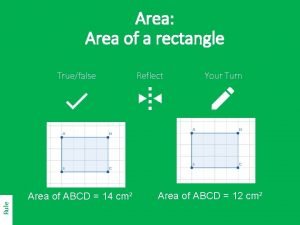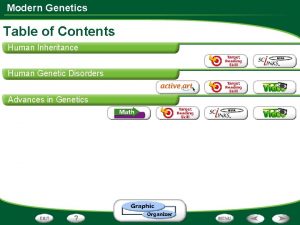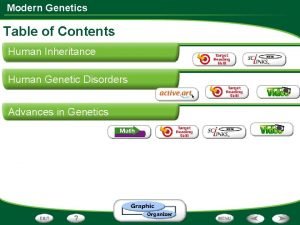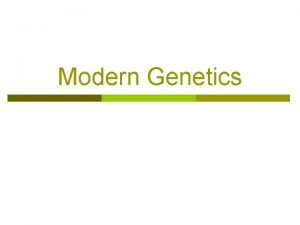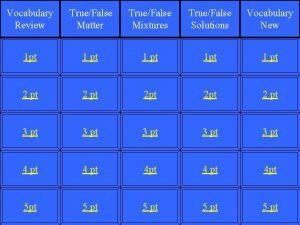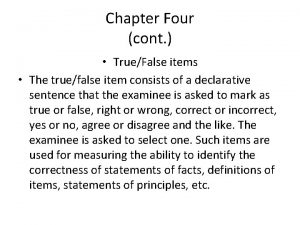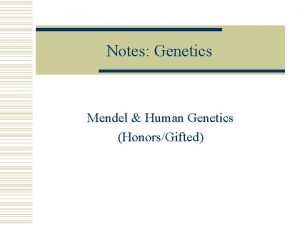Do Now Genetics TrueFalse Quiz 1 Human contains






- Slides: 6

Do Now: Genetics True/False Quiz 1. Human contains 23 pairs of chromosomes 2. 2 bases in DNA code for one amino acid 3. Sex chromosomes for female are XY 4. Phenotype is the physical characteristic of a gene 5. Meiosis generates somatic cells 6. Sperm is a gametic cell 7. Genes are sequences of DNA that code for proteins 8. DNA is found in cytoplasm 9. Variation makes us different from each other 10. Sex chromosomes for male are XY

_____: Any change in the base sequence of a gene, which may cause a different protein to be produced. Genetics Topic Test Somatic cell: _________________ DNA: _____________ DNA is made up of ______ (one base, one sugar and one phosphate) Found in: _____________ Structure: _____________ Genes: _________________________ Chromosomes: Made up of: _______________ Human has: __ or __ pairs chromosome (_______ – 2 sets of chromosome). ______: A reproductive cell Example: Sperm, Egg Cell replication _______: sexual reproduction that results in four different cells (gametes) with half the number of chromosomes of the parent cell (23 chromosomes – haploid). _______: asexual reproduction that results in two identical cells with the same number of chromosome (23 pairs of chromosome – diploid). ______ Population genetics and Species Survival Proteins: _ bases in DNA codes for one amino acid. Chain of Amino acids make up a protein Example: Allele (____): Alternative form of a gene that is located at a specific position on a specific chromosome. Every gene there are ___ alleles, one from each parent. _____: Physical characteristic that is coded by the genotype. ____ Allele (Capital letter): Physical characteristic will always be expressed. ____ Allele (lowercase letter): Physical characteristic will be expressed only when two recessive alleles of the same gene are present. Example: Homozygous Dominant: Heterozygous: Homozygous Recessive: _____: Individual that possesses characteristics different from the others of the same kind. _______________________ How sex is determined: __________________ __ chromosomes = Male __ chromosomes = Female Natural selection: ____________________: Family tree but with the passage of a single genetic trait (phenotype) over several generations. ________: A method of following alleles as they pass from one generation to the next and predicting what phenotype offspring may carry. Test cross

NCEA Question 1: Genetic structure The diagram below shows the relationship between chromosomes, genes, and DNA (deoxyribonucleic acid). a) Explain the relationship between DNA, chromosomes and genes. You may add notes and labels to the diagram above to support your answers b) Explain how the relationships in your answers to a) lead to different characteristics and how this contributes to genetic variation.

NCEA Question 2: Patterns of Inheritance A blood disorder caused by red blood cells with an unusual curved (sickle) shape is inherited through a single gene with two possible alleles, normal and sickle. Use ‘H’ to represent the dominant allele, and ‘h’ to represent the recessive ‘sickle’ allele. a) Explain how two parents with normal blood cells can have a child with sickle-shaped blood cells. In your answer, you should: State the genotype of a child with the sickle-shaped blood cells State the genotypes of both normal parents Draw a Punnett square to show two normal parents can produce a child with sickle-shaped blood cells.

NCEA Question 2 b) The parents in part a) have four children all with sickle-shaped blood cells. They are expecting a fifth child. i. Explain how normal parents could have produced FOUR children with sickle-shaped blood cells. You should refer to your Punnett square in a). ii. Explain what the chances are of the fifth child having sickle-shaped blood cells.

Answers http: //www. nzqa. govt. nz/ncea/assessment/search. do? query=Science&view=exams&level=01 90948 - Demonstrate understanding of biological ideas relating to genetic variation Exemplar answer script 2012 – Excellence Exemplar answer script 2012 - Merit Exemplar answer script 2012 - Achievement
